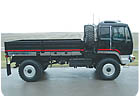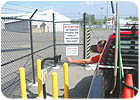ACCESSControl: Blast & Ballistic Door Selection Criteria

The need for appropriate door assemblies to resist man-made threats has greatly increased. There are no nationally recognized building codes, such as the International Building Code, that offer selection requirements. In addition, there are numerous government, military and association security standards that are somewhat obscure, use differing definitions and performance criteria or use methods of testing or classifications that conflict with other similar standards. Finally, many current military and government standards are considered sensitive and not suitable for general public display, let alone discussions within technical trade publications.
Fortunately, numerous manufacturers now produce off-the-shelf man-made threat-resistant door assemblies. They have been tested and certified by independent laboratories to ensure their advertised levels of protection have been achieved.
Define threat first
So, if given the opportunity to select a man-made threat resistant door assembly, coupled with the variety of readily available products, where to start?
To begin, it is important to define “man-made threats.” For the purposes of this article, man-made threats are defined as human acts that are generated with the intent to harm others and destroy property, such as terrorism, and criminal and civil disturbances. Other threats include natural acts and technological threats, or more appropriately defined as technological accidents. Those types of threats require a number of special considerations.
With this in mind, there are three types of man-made threats that relate to the selection of resistant door assemblies: forced entry attacks, ballistic attacks and blast attacks.
Door assemblies, as discussed here, are units that include single- or double-leaf, swing-type doors. Each door leaf can be no wider then 4 feet, no taller then 10 feet and no thinner then 1.75 inches, with steel frames and security-type hardware. They are typically constructed from heavy-gauge, steel face sheets secured around custom-engineered, steel rib cores with interior heavy gauge plates. They can achieve fire labels indicating resistance to fires for up to three hours duration, in accordance with NFPA-80 - Fire Doors and Fire Windows requirements as certified by UL or Warnock Hersey Intl. They can have glazing, but the selection process for glass components can be somewhat different. Finally, they should be warranted for five years. Keep this in mind, as warranties are critical for impact selections and final appearances.
Now, what level of performance?
Forced entry attacks
Door assemblies that have a forced entry (FE) attack rating are capable of withstanding various burglaries and civil disturbance-type threats that use handheld tools for a specific period of time.
Older requirements have been recently refined by various current codes into “resistance from concentrated assaults,” measured in minutes of resistance, in lieu of simple impact resistance. Thus, forced entry ratings are currently specified as:
- Five minutes of protection
- 15 minutes of protection
- 60 minutes of protection
For example, a five-minute FE-rated door assembly is certified to withstand two attackers who produce two “fair hits” from a 12-lb. sledgehammer, two hits from a carpenter’s 3-lb. hammer, one hit from a 120 ram – as well as 13 other impact tests using other tools – for a period of five minutes without the door opening or general component operational failure.
A 15-minute FE-rated door is certified to withstand six attackers who produce two hits from a 12-lb. sledgehammer, two hits from a carpenter’s 3-lb. hammer, one hit from a 120 ram – as well as 28 other impact tests using other tools – for a period of 15 minutes without the door opening or general component operational failure.
A 60-minute FE-rated door is certified to withstand six attackers who produce two hits from a 12-lb. sledgehammer, two hits from a carpenter’s 3-lb. hammer, one hit from a 120 ram – as well as 28 other impact tests using other tools – for a period of 60 minutes without the door opening or general component operational failure.
Ballistic attacks
Doors that have a ballistic resistance (BR) attack rating are capable of withstanding various gunshot bullet threats. Current ballistic resistance standards typically derive from UL Laboratories: UL 752 – Standards for Safety for Bullet Resisting Equipment Criteria, Table 3.1, dated Jan. 27, 1995. These criteria indicate eight levels of UL tested ballistic resistant protection.
A UL Level 1 ballistic-protected door assembly is the least resistant, and will only withstand three shots from “medium powered” small arms, for example a 9mm or .38 automatic handgun with muzzle energy up to 460 ft-lbs. A UL Level 2 ballistic-protected assembly will withstand three shots from “high powered” small arms, for example a .357 Magnum handgun with muzzle energy up to 663 ft-lbs.
UL Level 3 assemblies will withstand three shots from “high powered” small arms, for example a .44 Magnum handgun with muzzle energy up to 1,175 ft-lbs. UL Level 4 assemblies will withstand multiple one-shots from high-powered hunting and sporting rifles, for example a .30-06 or .30 caliber rifle with muzzle energy up to 3120 ft-lbs. UL Levels 5 through 8 ballistic-protected assemblies are the most resistant, and will withstand five shots from high-powered military assault rifles ranging in bullet size from 9mm with muzzle energy up to 3048 ft-lbs, to a 12-gauge with muzzle energy up to 3048 ft-lbs and including armor piercing bullets. Ballistic attacks may also include punching-type threats from shrapnel, or high-powered projected metal fragments that may result from an explosion.
Door assemblies can have combined threat resistance. A typical example is the FE/BR door assembly, an acronym for “forced entry and ballistic resistant.” Door assemblies with FE/BR capabilities achieve ratings as listed above. An example is a door assembly with FE/BR rating of 15 minutes (for FE) and Level 3 rating (for BR)
Doors that have a blast resistance attack ratings are capable of withstanding various magnitude (or sizes) of blast and associated air pressure threats. Current blast resistant standards reference door assembly ratings as follows:
- Low Range units 15-psf to 2-psi
- Mid Range units 3-psi to 10-psi
- High Range units 10-psi to 50-psi
The magnitude of a blast attack may best be understood using readily available GSA criteria. The Interagency Security Committee of the U.S. General Services Administration (GSA) developed criteria for blast mitigation design – albeit primarily for window systems – that includes a building blast category, or building types and their applicable levels of protection. The GSA Security Criteria, dated Oct. 8, 1997, was further clarified with the administration’s GSA Facilities Standards for Public Building Service (PBS-100), in March 2003.
These criteria indicate five categories of building types. Category Type A applies to unprotected buildings and is the lowest level of protection. Type C recommends a level of blast construction protection to withstand a 4-psi maximum blast pressure and a 28-psi-ms maximum blast impulse. This blast corresponds to the threat from a TNT bomb (typically a car bomb), weighing 425 pounds and detonated at a distance of 180-feet from the face of the building.
Obviously, smaller bombs situated closer can cause equal or greater damage. Category Type D recommends a level of blast construction protection to withstand a 10-psi maximum blast pressure and 89-psi-ms maximum blast impulse. This blast corresponds to the threat from a TNT bomb (typically a truck bomb), weighing 2,500 pounds and detonated at a distance of 200-feet from the face of the building.
Blast-resistant systems are not rated to include punch resistance of shrapnel or high-powered projected metal fragments resulting from an explosion. Should shrapnel or punch resistance be an additional design concern, then ballistic resistant systems are required, as discussed above.
Development of blast-resistant door assemblies requires peak positive blast over-pressure, and specific positive phase impulse. The blast pressure is the maximum positive-phase reflected air blast pressure, measured in pounds per square inch. The blast impulse is the integral of the measured positive phase reflected air blast pressure time history, measured in pounds per inch-milliseconds or “psi-ms.” Blast pressure was previously tested using static pressure resistance, which was performed by subjecting a door assembly to an ever-increasing pressure load applied over 30 seconds. Currently, most manufacturers use dynamic testing methods, which more closely simulate an actual explosive event.
Hardware issues
Hardware selections for man-made threat resistant door assemblies are now typically limited to components offered by the door assembly manufacturers. Utilization of the manufacturer’s components is required to achieve door assembly warranties. Unfortunately, their limited selections leave much to be desired in terms of aesthetic appeal, particularly for high-end users in modern corporate, governmental or judicial environments. Their hardware is generally custom-engineered components, which usually include latching systems with bulky and industrial-looking exposed rods, and even bulkier heavyweight hinges.
The latch point between the door and frame is typically the weakest point of any door assembly, so hardware selection is of particular importance. Typically, multiple latch points include a one-point (door bolt) lock set with two or three additional key-operated dead bolts about 24-inches above and below the lock set. These sets often have exposed reinforcement plates and exposed fasteners. Of note, latching that requires more then one operation are generally not suitable for code-complaint means of egress door assemblies, as indicated in NFPA - 101 Life Safety Code, 2003 Section 7.2.1.5.9.2.
Standard off-the-shelf hardware is currently not readily available or rated for forced entry, ballistic or blast levels of protection. Quality hardware can be classified as “Grade 1,” which relates to its strength and longevity performance when tested against ASTM standards, but Grade 1-designated hardware generally applies to non-threat environments and is not intended to indicate compliance with the higher levels of man-made threats.
For example, integral, concealed, three-point latching systems – where three latches are retracted with one hand turn operation – and that have tapered bolts – which is the preferred bolt profile to insure continued operation following a threat event causing door movements – for either standard locksets or exit hardware are, in the author’s knowledge, nonexistent. Attempts to select or create custom aesthetically pleasing deviations or improvements beyond the manufacturer’s limited standards require, once again, complete door assembly specimen testing to verify their ability to match the door assembly’s performance-based requirements.
Off-the-shelf electronic strikes, which are becoming more common with electronic access control, also are not yet available to meet the lower levels of forced entry resistance requirements, let alone blast or ballistic resistance.
Hopefully, hardware manufacturers will keep up with architects’ never-ceasing demands for pleasing configurations, and will begin to offer a variety of aesthetically pleasing, off-the-shelf components, such as hinges, electrified hinges, latch sets with concealed integral, single-operation, three-point integral latching, and exit sets with concealed three-point integral latching, that can be incorporated with man-made threat resistant door assemblies, without sole reliance on the door assembly manufacturer’s limited variations. Maybe this article will spark some excitement.
Quality assurance
The construction process must also include careful considerations of the construction for abutting walls and frame anchorage, to insure the walls strength and frame anchorage matches or exceeds that of the door assembly. The door assembly manufacturer and structural engineer should be consulted.
The Construction Specification Institute (CSI) Masterspecs, which are considered the initial starting format for specifying door assemblies, still offer specifiers the ability to require test specimens for threat-resistant doors. However, man-made threat-resistant door assemblies can be easily specified to achieve performance criteria without the need for costly test specimens, except under unusual circumstances.
The construction process involved with the installation of man-made threat-resistant doors should include receipt of the door assembly manufacturer’s tests and reports, as well as submittals indicating compliance with performance requirements and referenced standards. The work should be limited to qualified manufacturers with a proven track record of producing similar man-made threat-resistant door assemblies, and the work should be performed by installers certified as acceptable by the door assembly manufacturer.
On-site testing and inspections, including dismantling select doors and frames to observe internal construction, reinforcements and welding conditions, is recommended to verify compliance with performance requirements. Finally, a warranty with affidavit indicating compliance with specified performance requirements should be required.
Given these procedures, hopefully the selection process will be easier and greater secured environments, accessed by man-made threat-resistant door assemblies, can be achieved.

These Boots Are Made for Safe Walking
Anti-personnel mines, often seen in internal wars in foreign countries, are now a terrorist threat in developed countries including the United States. There are soft and high tech ways to handle these devices. For example, the Spider Boot design, created by GadShaananDESIGN on behalf of Med-Eng Systems, protects wearers’ feet and legs against blast-type anti-personnel mines. It can be worn in difficult terrains during reconnaissance, detection and removal, and victim-assistance operations. Several NATO and other military organizations, as well as international humanitarian demining agencies have issued the Spider Boot to personnel for use in operations.

Wireless Access Before They Get In
In many enterprise and government facilities, wireless access can provide perimeter and special location protection. According to Lester LaPierre, Schlage Wireless Access Products, Ingersoll Rand Security Technologies, wireless should be reviewed for any application but the following four especially send up flags for the use of wireless access control:
Need architectural integrity. Whether it’s installed in new modern buildings or historical landmarks, wireless locking systems preserve the integrity of the architectural design. Another plus – potential asbestos issues are avoided entirely.
Elevators. While traveling cables are routinely included at the time on installation, they are often ill equipped to reliably transport credential data from the cab to the elevator controller. Elevator shafts are harsh electrical environments and are often the source of data corrupting noise that becomes induced onto the card reader data lines. This causes inconsistent performance, which often gets worse over time as cable shielding decays due to continual movement.
Conversely, wireless solutions eliminate the need for the data lines in elevators up to 1000 feet. In fact, they thrive in this environment and provide consistent, reliable data transport that doesn’t wear out. With traveling cable installation costs ranging from $2,600 to $13,000 or more per cab, wireless alternatives can save thousands of dollars per elevator.
Eliminate trenching. For outdoor applications like vehicle and pedestrian gate access, wireless links can bridge up to 1000 feet line of site eliminating costly trenching. Wireless systems are ideal for garages, parking lots, airports, utility companies and military bases. They are especially cost effective for controlling gates around a facility. Even more impressive – optional directional or gain antennae are available for still longer distances, such as the installation at a Middle East oil field where gates are controlled about 4000 feet away.
Easy temporary access points. Wireless, portable readers provide a quick and easy way to validate credentials for manned applications like checkpoint access, construction zone access, bus loading, perimeter expansion, mustering, and special event attendance. Simply take the wireless portable reader to the temporary location, and have card holders present their credentials. Operation is simple – a green light on the portable reader signifies a valid card; a red indicates an invalid card. The best part is all transactions are online and real-time from the same centralized database.
Looking for a reprint of this article?
From high-res PDFs to custom plaques, order your copy today!







